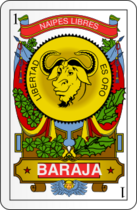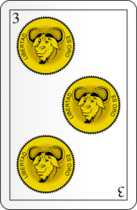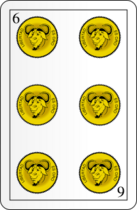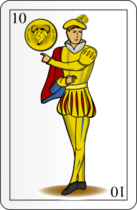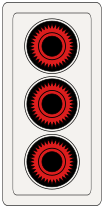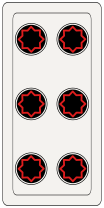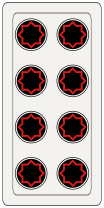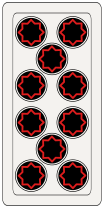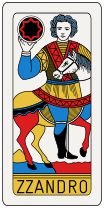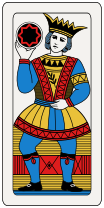| Coins | |
|---|---|
 Symbol from Trentine pattern Symbol from Trentine pattern | |
| Native names |
|
| Decks | |
| Invented | 13th-14th century |

The suit of coins is one of the four card suits used in Latin-suited playing cards alongside swords, cups and batons. These suits are used in Spanish, Italian and some tarot card packs. This suit has maintained its original identity from Chinese money-suited cards. Symbol on Italian pattern cards: ![]() Symbol on Spanish pattern cards:
Symbol on Spanish pattern cards: ![]() Symbol on French aluette cards:
Symbol on French aluette cards: ![]()
Characteristics
The coin suit may have originated from pips on Chinese dominoes, or as a play money substitute for paper money in use for gambling.
Lu Rong's (1436–1494) account of the Chinese money-suited 38-card Madiao deck has the suit of coins as Cash with ranks one to nine. Korean poet Jang Hon (1759-1828) wrote that the Madiao game dates even earlier, back to the Yuan dynasty (1271-1368). The ranks are in reverse order with the lower numbers ranking greater than the higher numbers. This features in many other early card games like Ganjifa, Tarot, Ombre, and Maw. In Moghul Ganjifa, two of the eight suits feature coins: "Safed" (silver coins) which ascends from 1 to 10, and "Surkh" (gold coins) which descends from 10 to 1. By the late 16th-century, the suit of Cash added two more cards, the Half Cash and Zero Cash. During the 18th and 19th centuries, these two cards became suitless and took on new identities as the White Flower and Red Flower respectively. Mahjong tiles derived from money-suited decks in the middle of the 19th century and retains the coin suit. The Hakka's Six Tigers deck, Vietnamese Tổ tôm and Bài chòi decks, Thailand's Pai Tai deck, and Malaysia, Singapore, and Indonesia's Ceki or Cherki deck all maintain the Chinese money-suit of coins.
In Spain, the suit of coins is known as oros and the court cards are known as the rey (king), caballo (knight or cavalier) and sota (knave or valet). The Spanish play with packs of 40 or 48 cards. There are no tens and, in the shorter pack, the nines and eights are also dropped. Thus the suit of coins ranks: R C S (9 8) 7 6 5 4 3 2 1.
In Italy the suit is known as denari and the corresponding court cards are the re, cavallo and fante. Either 40 or 52-card packs are used. In the shorter packs, the tens, nines and eights are removed. Card ranking is thus: R C F (10 9 8) 7 6 5 4 3 2 1. In the French vendée where they play aluette with a special pattern of 48 Spanish-suited cards, the suit is called denier and there are the courts are the roi, cavalière, (female cavalier) and valet (jack).
Portuguese-suited playing cards were traded to Japan in the mid-16th century which influenced the development of Karuta where the 48-card Komatsufuda and 75-card Unsun Karuta decks still maintain this suit.
The suit of coins is also one of the four suits in tarot card packs used for tarot card readings and other cartomancy.
Gallery
Spanish pattern
The gallery below shows a suit of coins from a Spanish-suited deck of 48 cards. The pack is of the Castilian pattern:
Italian pattern
The gallery below shows a suit of coins from an Italian-suited deck of 52 cards. The pack is of the Bresciane pattern:
Mahjong pattern
The gallery below shows a suit of coins from a Mahjong set of 144 tiles. Also included are the red and white dragons:
Ceki pattern
The gallery below shows a suit of coins from a Ceki deck of 60 cards. Also included are the red and white flowers:
Six Tigers pattern
The image below shows a suit of coins from a Sichuan Six Tigers deck of 36 cards. The suit's name is written as (Chinese: 戋), simplified from the character (Chinese: 錢; pinyin: qián) meaning "money":
 9 (戋九), 8 (戋八), 7 (戋七), 6 (戋六), 5(戋五), 4 (戋四), 3 (戋三), 2 (戋二), 1 (戋一)
9 (戋九), 8 (戋八), 7 (戋七), 6 (戋六), 5(戋五), 4 (戋四), 3 (戋三), 2 (戋二), 1 (戋一)
Tổ tôm pattern
The image below shows a suit of coins from a Tổ tôm deck of 120 cards. The suit's name is written as (Chinese: 文; pinyin: wén) meaning "Chinese cash (currency unit)":
 1 (文一), 2 (文二), 3 (文三), 4 (文四), 5 (文五), 6 (文六), 7 (文七), 8 (文八), 9 (文九), Half (文半)
1 (文一), 2 (文二), 3 (文三), 4 (文四), 5 (文五), 6 (文六), 7 (文七), 8 (文八), 9 (文九), Half (文半)
Komatsufuda pattern
The image below shows a suit of coins from a Komatsufuda deck of 48 cards:
 Ace, 2, 3, 4, 5, 6, 7, 8, 9, Knave, Knight, King
Ace, 2, 3, 4, 5, 6, 7, 8, 9, Knave, Knight, King
Unsun karuta pattern
The image below shows a suit of coins from an Unsun karuta deck of 75 cards:
 Ace, 2, 3, 4, 5, 6, 7, 8, 9, Knight, King, Female Knave, Sun, Un, Dragon
Ace, 2, 3, 4, 5, 6, 7, 8, 9, Knight, King, Female Knave, Sun, Un, Dragon
Individual cards

- Seven of coins. The seven of coins is the most valuable individual card in Italy's national game of scopa. Known as the sette bello ("beautiful seven"), capturing it is one of four achievements that earns a game point. This card inspired the name for the Settebello (train), which in turn inspired the name for Sette Bello, the racehorse. The card also inspired the nickname to Italy men's national water polo team.
- Ace of coins. In some Italian patterns the ace of coins is represented by an eagle. Similar to the ace of spades, it often has a more ornate design due to it being used for the stamp tax.
See also
- Spanish-suited playing cards
- Italian playing cards
- Coins – suit used in divinatory tarot cards
Notes and references
- Wilkinson, William Henry (1895). "Chinese Origin of Playing Cards". American Anthropologist. VIII (1): 61–78. doi:10.1525/aa.1895.8.1.02a00070.
- Lo, Andrew (2000). "The Late Ming Game of Ma Diao". The Playing-Card. 29 (3): 115–136.
- Yi, I-Hwa (2006). Korea's Pastimes and Customs: A Social History (1st American ed.). Hong Kong: Hangilsa Publishing Co. p. 31.
- Pati, Arunima (June 11, 2020). "An Introduction to Ganjifa Cards". Indian Numismatic, Historical and Cultural Research Foundation. Retrieved June 20, 2024.
- Parlett 2008, p. xv.
- Parlett 2008, p. 410.
Literature
- Parlett, David (2008). The Penguin book of card games. London: Penguin. ISBN 978-0-14-103787-5. OCLC 229463734.
This card game–related article is a stub. You can help Misplaced Pages by expanding it. |
